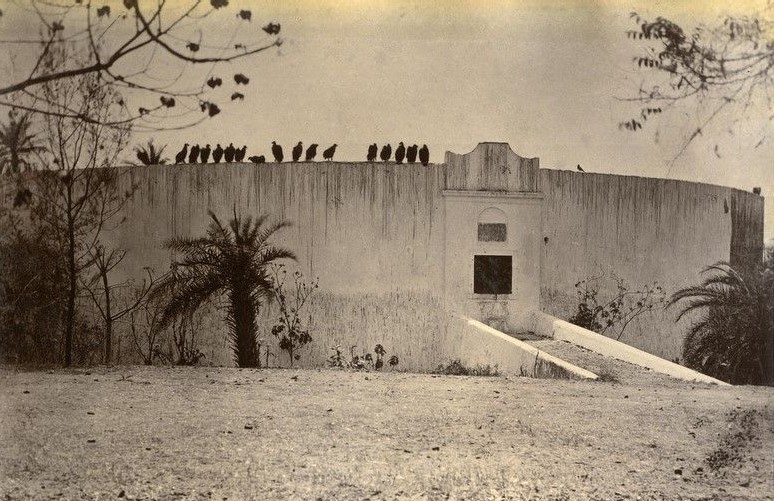By
Jose Kalathil
Absence of vultures has forced a minority community of Zoroastrians, who had emigrated to India centuries ago, in Navsari in Gujarat state, considered the Vatican of Zoroastrianism, to change to burials instead of their traditional way of putting dead bodies inside Dakhmas or Towers of Silence, to be disposed of by the sun and carrion birds.
Usually built on a hilltop, dakhma is a round stone or brick structure about 15 meters high and 100 meters wide, with an internal platform on which sit three ranks of stone slabs, for the bodies of men, women, and children, sloping down toward a central dry well. Within an hour or so after a body is placed there, vultures reduce it to bones. Some days later, the corpse-bearers return and throw the bones down the central well, which is filled with sand and charcoal.
Dakhmas in Mumbai still receive 800 bodies every year. But in the absence of vultures, bodies rot for months. The main reason for the decline in their population is the drug diclofenac. The anti-inflammatory medicine was introduced for humans in the 1970s. When it was added to veterinary medicines in the 1990s it killed vultures that fed on caracasses of cattle treated with the drug. Thus the number of white-backed vultures, the most common, declined by 99.9%. In 2008, India banned the drug in veterinary medicines. The drug causes renal failure due to which birds cannot excrete uric acid through their kidneys which leads to visceral gout, ultimately killing them.
Zoroastrians believe in the immortality of the soul, which they consider will remain around the body for three days. At the beginning of the third night, the soul will be judged by the Spiritual judge Mitra at the Chinvat Bridge between this world and the next. If one’s good actions outweigh evil actions, he will proceed to Heaven; otherwise to Purgatory or Hell.
Parsis number 1,38,000 world over, spread mostly in India 69,000, US 40,000, Iran 25,000, Afghanistan 10,000, Canada 5,000, Pakistan 5,000, Singapore 4,500, UK 4,100, Australia 2,700, Gulf countries, Azerbaijan, New Zealand 2000 each and Germany 300, according to FEZANA Journal, a quarterly publication of the Federation of Zoroastrian Associations of North America (FEZANA), 2012.
Parsis are followers of the Iranian prophet Zoroaster, who initially settled at Hormuz on the Persian Gulf, but finding themselves persecuted they set sail for India, arriving in the 8th century. The migration may in fact have taken place as late as the 10th century, or in both.
Aggravated by low birth and marriage rates, immigration and the exclusion of children born to women married to non-Zorastrians, their number has dwindled considerably. According to Parsiana weekly, the fortnightly of the Parsi Zoroastrian community, in 1988, 14% of the marriages had a non-Zoroastrian spouse; in 2015, 37% of weddings were mixed. The community has produced Dadabhai Naoroji, one of the leaders of India’s freedom struggle, and Jamsetji Nusserwanji Tata, the founder of one of the successful business conglomerates, Tata Groups.
Over the centuries since the first Zoroastrians arrived in India, the Parsis have integrated themselves to Indian society while maintaining or developing their own distinct customs and traditions.
One-fifth of the decrease in population is attributed to migration. A slower birthrate than death rate accounts for the rest: as of 2001, Parsis over the age of 60 make up for 31% of the community. Only 4.7% of the Parsi community are under six years of age, which translates to seven births per year per 1000 individuals. Concerns have been raised in recent years over the rapidly declining population of the Parsi community in India.



No Comments Yet!
You can be first to comment this post!